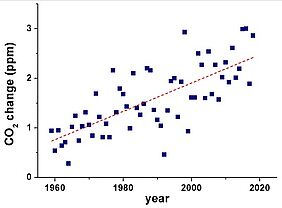With ever-increasing levels of carbon dioxide in the atmosphere, concerned scientists are looking for ways to mitigate the negative impacts of this development for our planet. One of the easiest and also most sustainable methods would be to simply collect the greenhouse gas and turn it into fuel.
Now (2021), scientists at Brookhaven Laboratory have found a means to create an almost zero-net-carbon technology which is able to sustainably convert the greenhouse gas CO2 and hydrogen into ethanol, which could then be used as fuel and other chemical applications. Their study outlines a roadmap for successfully controlling the chemical reaction and describes the full reaction sequence using theoretical modelling and experimental characterisation.
In the study, the scientists found that combining caesium, copper, and zinc oxide in a close-contact configuration served as catalyst for a reaction pathway that could convert carbon dioxide (CO2) into ethanol (C2H6O). They also discovered the mechanisms of how this three-part interface worked. None of the three components analysed in the study was capable of bringing about the CO2-to-ethanol conversion individually or in pairs, but when the three elements were combined in a certain configuration they opened up new possibilities of the carbon-carbon bond formation that enabled the conversion of CO2 to ethanol. The interface was created by depositing tiny amounts of copper and caesium onto a surface of zinc oxide. To analyse the regions where the three materials joined, they used an x-ray technique called x-ray photoemission spectroscopy, which showed a change that was taking place in the reaction mechanism for CO2 hydrogenation when caesium was added. More information was gained using two widely-used theoretical approaches: density functional theory calculations, a computational modelling method to analyse the structures of materials, and kinetic Monte Carlo simulation, a computer simulation to simulate the reaction kinetics. One of the things the scientists learnt from the modelling was that the caesium was an important component of the active system. Without it, ethanol could not be produced. Moreover, good coordination with copper and zinc oxide was also important.
One of the superordinated goals of this research is to find an ideal catalyst for CO2 conversion to higher alcohols which might be more useful and desirable for industrial applications and the production of commodities. The catalyst analysed in this study was advantageous in so far as copper and zinc oxide-based catalysts are widespread in the chemical industry and already used in catalytic processes such as methanol synthesis from CO2.
The conversion of CO2 into useful fuels has attracted a lot of industrial as well as scientific attention. In 2016 scientists developed an electrochemical process which used tiny spikes of carbon and copper to turn carbon dioxide into ethanol. The catalyst was made of carbon, copper and nitrogen. The reaction needed electricity to initiate a chemical reaction that essentially reversed the combustion process. With the help of the nanotechnology-based catalyst the solution of carbon dioxide which was dissolved in water could be converted into ethanol having a yield of 63 percent. As the technique relied on low-cost materials and could operate at room temperature in water, the researchers believed the approach could be scaled up for industrially-relevant applications.
In 2020 scientists designed a new process which was capable of electrochemically converting the carbon dioxide released from industrial processes into a valuable commodity at reasonable cost using a catalyst. The catalyst consisted of atomically-dispersed copper on a carbon-powder support. Through an electrochemical reaction, the catalyst disassembles carbon dioxide and water molecules and selectively reassembles the broken molecules into ethanol under an external electric field. Because the process worked at low temperature and pressure, it was able to start and stop quickly depending on the intermittent supply of the renewable electricity.
There are many advantages to green ethanol production and use: as a fuel, ethanol is safer and more potent than methanol. However, its synthesis is very difficult due to the complexity of the reaction and the difficulty of controlling the C-C bond formation. Therefore, knowing which kind of configuration is necessary to make the transformation and which role each component plays during the reaction, can be considered a big breakthrough. This type of process will eventually lead to technologies that are able to recycle CO2 emitted from combustion and convert it into usable chemicals or fuels.
The next step will be to focus on developing a practical industrial catalyst for selectively converting CO2 into ethanol. The follow-up studies are scheduled to take place at Brookhaven’s National Synchrotron Light Source II which has suitable tools and techniques for the characterisation of catalysts under working conditions and are aimed at getting a more detailed picture of the Cu-Cs-ZnO system and catalysts with a different composition.
